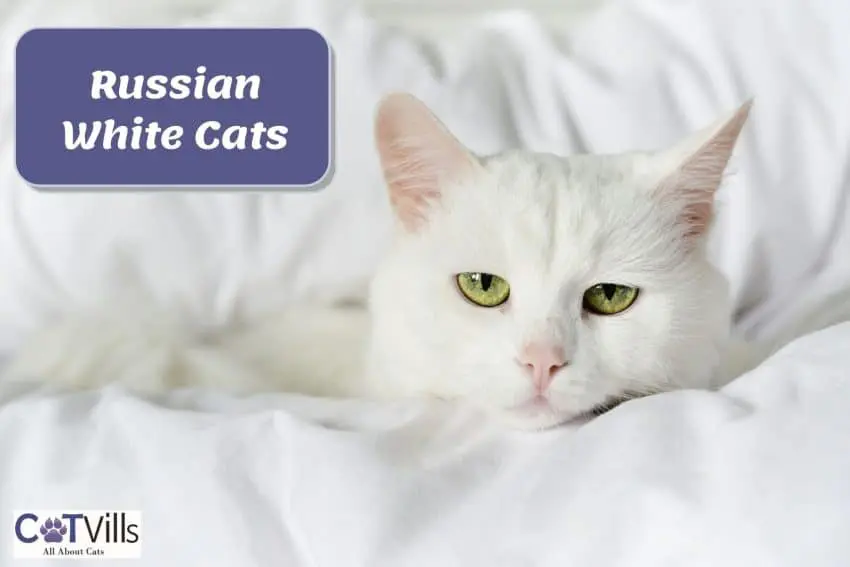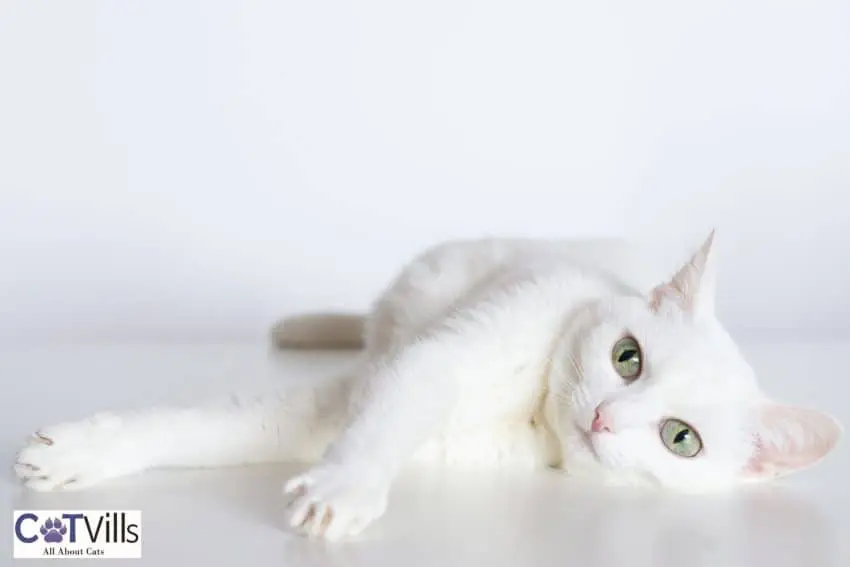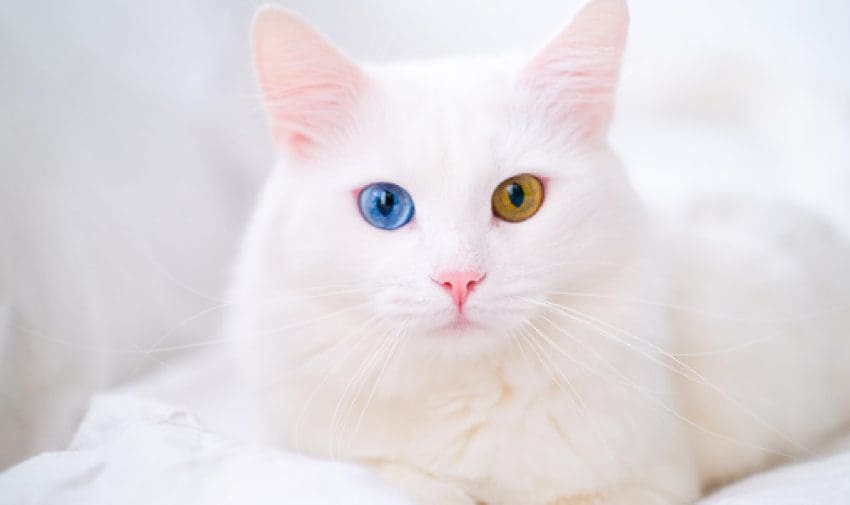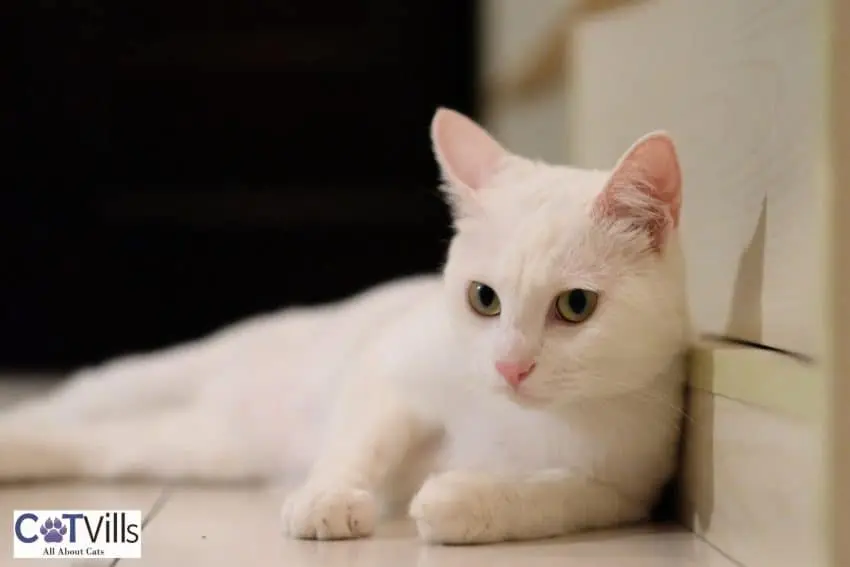Last Updated: 2 years ago
Are you wondering about Russian white cats and if they’re a suitable breed for you and your family?
Then you’re at the right place to learn all the important facts about these amazing white cats and their personalities.
Most people are familiar with the Russian Blue, the stunning blue-gray cat breed with its thick, soft coat, intelligent eyes, and docile disposition. After all, it’s the most amazing Russian cat breed.
However, despite popular belief, Russian Blues aren’t always blue. They can be white, black, or tabby, even though the breed standard calls for “even bright blue throughout.”
So, let’s learn more about how Russian White cats appeared.
Russian White Cats History and Origin

While the origin of Russian Blues goes back to the 19th century, the Russian White Cat is relatively “new.” Its history goes back to the 1960s in the UK and the 1970s in Australia.
In Australia, breeders Dick and Mavis Jones of Myemgay Cattery crossed a “domestic” Siberian cat with their Russia Blue. The result was two white kittens, one of which they named White Rose.
As the Australian breeders wrote, “White Rose grew to be a beautiful white queen, long, svelte, and elegant, with all the appearances and charming characteristics of the Russian Blues.”
They produced the second generation of white Russian kittens by mixing the first generation with Blue Russian males, and they continued to establish the breed in Australia.
As for the UK breeding line, it started with a white female kitten named Arctic Chumvi. The breeder, Frances McLeod, crossed this white Russian kitten with a Russian Blue male.
In these years, the Russian breed was declining in the UK, and the gene pool was limited. So, Frances’ decision was an attempt to widen the gene pool and save the breed.
Interestingly, Chumvi’s third litter had a black kitten, which is how the stunning Russian Black appeared.
Cat Association Recognition
In general, cat organizations in South Africa, New Zealand, and Australia fully recognize the Russian White Cat as a separate breed.
However, CFA (The Cat Fancier Associaton), TICA (The International Cat Association), and other breed registries don’t recognize any other colors but blue.
Still, the CFA has given White and Black Russian cats championship status and allowed them to compete since 2010.
Here are some cute white kitten name ideas.
How Rare are Russian Whites?
In general, pure white cats are rare, only 5% of the general cat population. Moreover, the breed is relatively new compared to other popular cat breeds.
As such, Russian Whites are quite rare and expensive pets.
If you’re thinking about getting a white Russian kitten, you should contact breeders specializing in Russian cats and ask if they have one.
Don’t buy kittens from shady breeders because there’s no guarantee you’ll get a genuine White Russian Cat.
Since Russian Whites are rare, you can expect to pay up to $2000 for a purebred kitten. The price depends on the gender and the pedigree.
Russian White Cats Appearance

Russian White Cats are identical in appearance to Blues, with the only major difference being their coat color. They’re medium-sized cats with muscular bodies and a regal appearance.
In general, most Russian White Cats weigh between seven and 15 pounds and are between 15 and 18 inches tall (without the tail). As usual, males tend to be bigger than females.
Head and Body
The breed standard calls for a medium wedge-shaped head with a broad face, a blunt muzzle, and wide-set eyes. The ears are large and wide, with pointed tips.
As I already said, the body is muscular but graceful, while the neck is long and slender. The feet are long and well-rounded, with small paws. The tail is straight and rather long.
Coat
Russian Whites have a short, dense double coat with a thick undercoat and a soft or silky overcoat. The coat is snowy white with no other visible colors.
However, kittens can have blue or black caps on their white coat, which should disappear by the time they’re one year old.
Eye Color
Russian White Cats should have vivid green eyes. Other eye colors are not acceptable. Kittens have yellow eyes in the beginning, but they turn green slowly.
How to Tell If My Cat Is Russian White?
Even an experienced cat breeder can have a hard time telling a Russian White from another breed of cat. That’s because over 15 breeds of cats can be white in color.
In general, a DNA test kit is the only way to confirm a breed when you don’t have your cat’s pedigree. It compares your cat’s DNA to a database of all the known breeds.
These tests are easy to make and require only a little bit of your cat’s saliva. But they can be expensive, and you’ll have to wait several weeks for the results.
Russian White Cats Personality

Russians are well-balanced, gentle cats with a calm disposition and playful nature. While reserved towards strangers, these stunning white cats are quite affectionate towards the family.
Your White Russian will gladly follow you around the house, perch on your shoulders while you’re working, or nap close to you while you’re watching TV. They’re sensitive and don’t like to be ignored.
Russian Whites and Blues get along great with children and are patient with small kids. They also tolerate other pets, such as dogs, and don’t mind being alone during the day.
As such, Russian Whites make great family pets.
However, Russians are a very intelligent breed and will be miserable if you don’t make up for your absence during the day. Provide plenty of interactive toys, scratching posts, and puzzles.
You can also train your Russian White to perform cat tricks. As I already said, they’re smart and quick to learn when properly motivated with food and treats.
These white cats don’t do well with change, and you’ll need to work hard to earn their trust and respect.
They also love climbing as high as possible and expect their meals to arrive at the same time every day.
As such, Russian Whites are better suited for quiet homes and people ready to commit. If you want a more social cat breed, go for Ragdolls or Siamese.
Russian White Cats Care Tips

Let’s talk about how to care for your Russian White cat if you’ve fallen in love with this breed and are considering adopting one for your household.
Grooming
In general, Russian Whites are easy-to-maintain cats. You need to brush the beautiful, snow-white coat at least twice a week to remove dead hairs.
Since the coat is short and dense, there won’t be many cat hairs around the house, and regular brushing can decrease the mess during the shedding season.
In general, frequent bathing isn’t good for cats because it strips the natural oils from their skin. You only have to bathe your cat when their white coat gets too dirty.
Besides brushing, Russian Whites need to have their teeth brushed. Cats and dogs are prone to dental disease, which can lead to kidney failure and other serious conditions.
Feeding
Purebred cats do best on high-protein cat food to maintain their luxurious white coat. Choose a high-quality cat food brand with meat as the first ingredient.
Follow the feeding instructions on the label or consult your vet about how much to feed your White Russian cat.
Exercise
As I already said, White Russians aren’t a lazy cat breed. However, they aren’t one of those active cats that will keep you on your toes all day long or destroy the house when you’re gone.
Provide plenty of interactive toys and puzzles to keep your Russian cat entertained during the day, and use treats to teach your cat some funny tricks.
Russian White Cats Health

In general, Russian Shorthairs are a healthy breed. They aren’t prone to genetic issues and can live up to 15 years with proper care.
However, since Russian cats like to eat a lot and are lazy around the house, you should watch out for obesity. Overweight cats are in danger of developing diabetes and kidney problems.
And you should keep in mind that many white cats are born deaf, even when they don’t have blue eyes.
As a cat specialist from Cornel University explains, “Researchers found that only 17 to 22 percent of white cats with non-blue eyes are born deaf.”
The percent is even higher in white cat breeds with one or two blue irises. Fortunately, deaf cats can live normal lives as long as you keep them inside and take precautions.
Conclusion
Russian White Cats make great family pets thanks to their gentle temperament, calm disposition, and intelligence.
However, these cats don’t trust strangers quickly, so you’ll need to be patient to build a solid relationship with your pet.
What do you think about White Russian cats? Have you ever seen one? Share your thoughts in the comment section.
Resources

